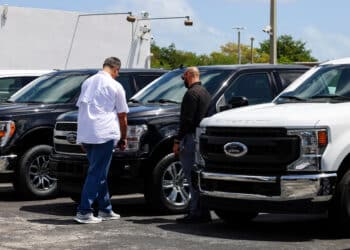Used-Car Values: How Lenders Manage Unexpected Appreciation

Roughly two years ago, the automotive market and the economy were heading for a peak year where lenders were aggressive, competition was stiff, and the economic environment was gaining strength. Since then, lenders have taken their foot off the gas, the economy has stabilized, and lenders have operated business as usual — while used-car values have risen to unexpected highs.
This year has been a curveball for lenders, with several factors causing what economists, lenders, and analyst are calling an “abnormal” appreciation in used-car values. First, the low interest rates dealers were used to touting are on the rise, spurring higher demand for used cars for consumers who have grown accustomed to lower payments and favor affordability over the expense of new vehicles.
Next, President Donald Trump threatened in June to slap a 25% tax on all imported auto parts. The move would hit manufacturers and trickle down to lenders, dealers, and inevitably consumers — bolstering new-car values and making used cars even more attractive.
In August, Manheim‘s Used Vehicle Value Index hit 139.7 — the second straight record high in in the index’s 20-year history.
“When you have this activity that’s out of the norm, the concern becomes what is going to happen and where is it going to go,” Doug Evans, senior director of remarketing for Hyundai Capital America, told Auto Finance News.
So how do captives and lenders adjust business strategies when used-car values increase instead of falling? Also, when will the trend reverse?
Tariffs, rising interest rates, and an influx of new consumers returning to the market are three factors that point toward continued demand. Singularly, the signs wouldn’t trigger a significant increase in demand, but combined they create a different story.
“We don’t know if tariffs are pulling ahead, but we won’t discount it,” Evans said, noting that 10 days after the president announced the tariffs, there was a surge in used-car sales. “We believe it has some impact, but we would not align that 100% behind July sales.”
In July, 3.4 million used vehicles were sold — for a SAAR of 39.5 million units — compared with a 39.2 million SAAR in June, according to Edmunds.
The question surrounding the tariff threat becomes how new prices will rise in the short term, said Jonathan Smoke, chief economist for Cox Automotive. “It largely depends on having a firmer verdict on tariffs,” he said.
Tariffs on auto parts are predicted to have consumers seeing new-vehicle prices increase by $4,400, on average, according to an analysis by the Center for Automotive Research. This price increase favors growth in used-vehicle sales at the expense of new.
While looming tariffs is an uncertainty, rising interest rates is more than a consumer’s worry — it’s a fact. “Rates will be at least 50 basis points higher by yearend,” Smoke said. So far, the Federal Reserve has increased interest rates three times this year — representing the Fed’s optimism about the state of the economy.
But these rate hikes are translating into higher borrowing costs for cars. As of Sept. 14, the annual percentage rate on used vehicles was 5.14%, according to Informa Research Services.
For lenders, the rising interest rate environment is an important risk factor to monitor, Kevin Cullum, president of Nissan Motor Acceptance Corp., told AFN. “As a captive, we’ll continue support to help the dealers adjust their business models as we get back into a normal interest rate environment,” he said. “However, [interest rates] continue to be the biggest risk that we have to manage.”
Although NMAC and other captives can’t control interest rates, they can provide dealers with options like extended terms or flexible leases. “It’s all about making sure [dealers] have the cash flow that supports the business, and the interest rate is a huge piece of that,” Cullum said. “Awareness and planning are key.”

It’s (Almost) Always About the Dealer
The foundation for higher used-car prices has been laid out in the past five years as dealer engagement in selling used cars has improved, said Jonathan Banks, vice president of vehicle valuations and analytics at J.D. Power.
“Dealers are buying [off-lease vehicles] and selling them through auction wholesale,” Cullum said. “They’re holding their values — well within the plans that [NMAC] had set three years ago, and in particular crossovers, they’ve been stronger. So the demand is there, and the residuals have been supported.”
In August, 3-year-old vehicles were worth 4.8% more than normal during this time of year, Manheim notes. NMAC, for one, has experienced this trend firsthand, Cullum said, as the captive’s off-lease portfolio shows 3-year-old vehicles in high demand.
At HCA, dealers have increasingly been buying the higher volume of off-lease vehicles “upstream” — that is, before they are transported to auction. That strategy has been the captive’s “secret sauce” to managing those values over time, Evans said. Buying upstream means that dealers are adapting to digital purchasing.
“This retail demand combined with the [price] appreciation has dealers flocking more to the digital and upstream to get to the inventory quicker, because they need it — rather than going to physical auction,” Evans said.
A strong CPO program is another driver of higher used-car values, since it allows off-lease vehicles to have a great landing spot, said Erick Gonzalez, national sales director for Hyundai Motor Finance.
“In this market, what we try to focus on is supporting dealer retail sales and profitability,” Gonzalez said. “Dealers have the right vehicle inventory to buy off-lease and carry to their used lots. Whether the cycle of used-car values goes up and down — it’s an enterprise. Anything that we can do to support dealers’ profitability, we will support that.”

For lenders, the conservative thing to do when used-car prices drop less than expected is to “continue to assume weakness and reap the benefits from the unplanned strength,” said Chuck Berend, director of U.S. auto lending for BBVA Compass. “My instinct around the industry is that we are about to see many participants adjust strategy.”
Lenders understand that they can take advantage of higher-than-expected used-car values by keeping those funds safe for the “rainy day” when values decline. However, the best way for lenders to leverage the extra funds is to channel the additional profits into retail incentives to generate for the dealers and customers to support originations, Gonzalez said.
Moreover, the higher market values have the potential to mitigate losses, reducing the depreciation expense that benefits lender profitability, said a Toyota Financial Services spokesperson. “Lenders are required to estimate their depreciation expense by considering their expectations for future used-vehicle market values. This is typically performed through analytics that estimate the positive and negative impacts of the various factors that influence used-vehicle values.”
However, lenders should look at the extra funds as an “unexpected bonus,” Berend said, noting the savings from higher used-car values is relatively small compared with a lender’s general funds. Still, the extra cash can provide operational flexibility and remove some of the cost pressure that lenders face.
Still, lenders should proceed with caution. Where you are and how you operate will influence the way used-car values impact lenders. “It’s a bonus you cannot count on,” Berend said. “The more used-car values don’t drop when expected, the more lenders are waiting around looking for when it will drop.”
Editor’s note: This story was originally featured in the October edition of Auto Finance News magazine, out now.
















